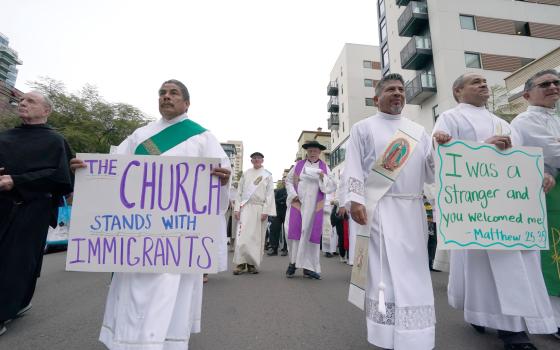
QR codes on a Boys Town map link smartphone users to information about historic sites in the Omaha, Neb.-area village for homeless and delinquent boys, founded by the late Fr. Edward Flanagan. (CNS/Catholic Voice/Susan Szalewski)
People have been touring Boys Town for nearly 100 years -- since Fr. Edward Flanagan purchased land for the campus in what is now west Omaha and welcomed visitors there.
But now tourists have a whole new way of exploring the famed home for at-risk children -- an interactive, smartphone guided tour.
"We're moving into a new age of tourism," said Tom Lynch, director of community programs at Boys Town.
Other historic Catholic sites in the Omaha archdiocese provide tours, including St. Cecilia Cathedral in Omaha and the scenic rural churches of St. Boniface in Elgin, St. Bonaventure in Raeville and several in Cedar County.
But Boys Town is unique with its smartphone tour.
Smartphone users can scan quick response codes, known as QR codes, found on maps and signs at the village to read about famous sites there. The "Visit the Village" section of the campus' website has details about various tours, including the interactive tour.
Lynch said he saw how businesses used the QR codes -- square, pixelated images found on labels, advertisements, even T-shirts -- to link users with information, and thought: "I bet that could be applied at Boys Town, too."
The smartphone tours reflect Flanagan's welcoming attitude, Lynch said. "He always had big signs welcoming visitors. He wanted transparency. He had no large walls keeping kids in and visitors out."
Boys Town officials will continue to upgrade the smartphone guided tour, adding audio and video, as they promote Flanagan's cause for canonization, opened two years ago by Omaha Archbishop George Lucas, and prepare for an influx of visitors, said Lynch, who also is chief historian for the canonization cause.
For example, over time, smartphone tourists may be able to hear Flanagan's voice, as well as the voices of alumni and current residents, and watch video from the 1930s and '40s, Lynch said in an interview with the Catholic Voice, the archdiocesan newspaper.
He said he hopes to have an area near Flanagan's tomb with a link on how to become active in the canonization cause, including contact information for the Father Flanagan League, a group of laypeople promoting the cause.
Boys Town -- which has about 100,000 people go through its campus each year, including people attending Mass or classes -- already is drawing visitors who want to know more about the founder, said Mary Huard, who as gift shop manager schedules Boys Town tours.
Boys Town received a state tourism grant to help develop the smartphone tour, Huard said. And in 2013, when the interactive tour was launched, the Nebraska Tourism Commission named Boys Town the state's outstanding tourism attraction, in part crediting the added technology.
For visitors who don't have smartphones, CDs can be rented or purchased to guide visitors as they drive through the campus.
Tours led by guides also are available seven days a week. Tour guides include Lynch, Huard, gift shop and museum employees, and Boys Town residents, including Boys Town Mayor Samuel "Sam" Saintizaire of Greenacres, Fla.
Huard recommended a student-led tour.
"That's the best thing to do," she said. "They can give you the history, but they also can tell you about what it's like to live here."
On any type of tour, visitors can learn about the world's largest ball of stamps, formed over the years by the youths at Boys Town, or see Spencer Tracy's Oscar award for best actor for his portrayal of Flanagan in the 1938 movie "Boys Town."
The tours are important because many people who travel to Omaha for sporting events, conferences or graduations also are curious about Boys Town.
"They've heard about Boys Town, and they want to know what it is," Lynch said.
[Susan Szalewski is on the staff of the Catholic Voice, newspaper of the Omaha archdiocese.]


